Corporate Accounting: Disclosure Levels and Debt Evaluation Report
VerifiedAdded on 2023/06/05
|15
|2897
|432
Report
AI Summary
This report provides an in-depth analysis of disclosure levels required in corporate accounting, emphasizing the importance of assessing these disclosures for effective financial reporting. It examines corporate regulations, including the roles of the International Financial Reporting System (IFRS) and the Australian Accounting Standards Board (AASB). A comparative debt evaluation of four ASX-listed public companies in the mining industry is conducted, analyzing their balance sheets and income statements over several years. The report also covers owner’s equity, including retained earnings, reserves, and contributed equity, and their impact on the financial condition of organizations. The analysis includes a debt-equity ratio comparison for the selected companies, providing a comprehensive overview of their financial health and practices. This document is available on Desklib, a platform offering study tools for students.
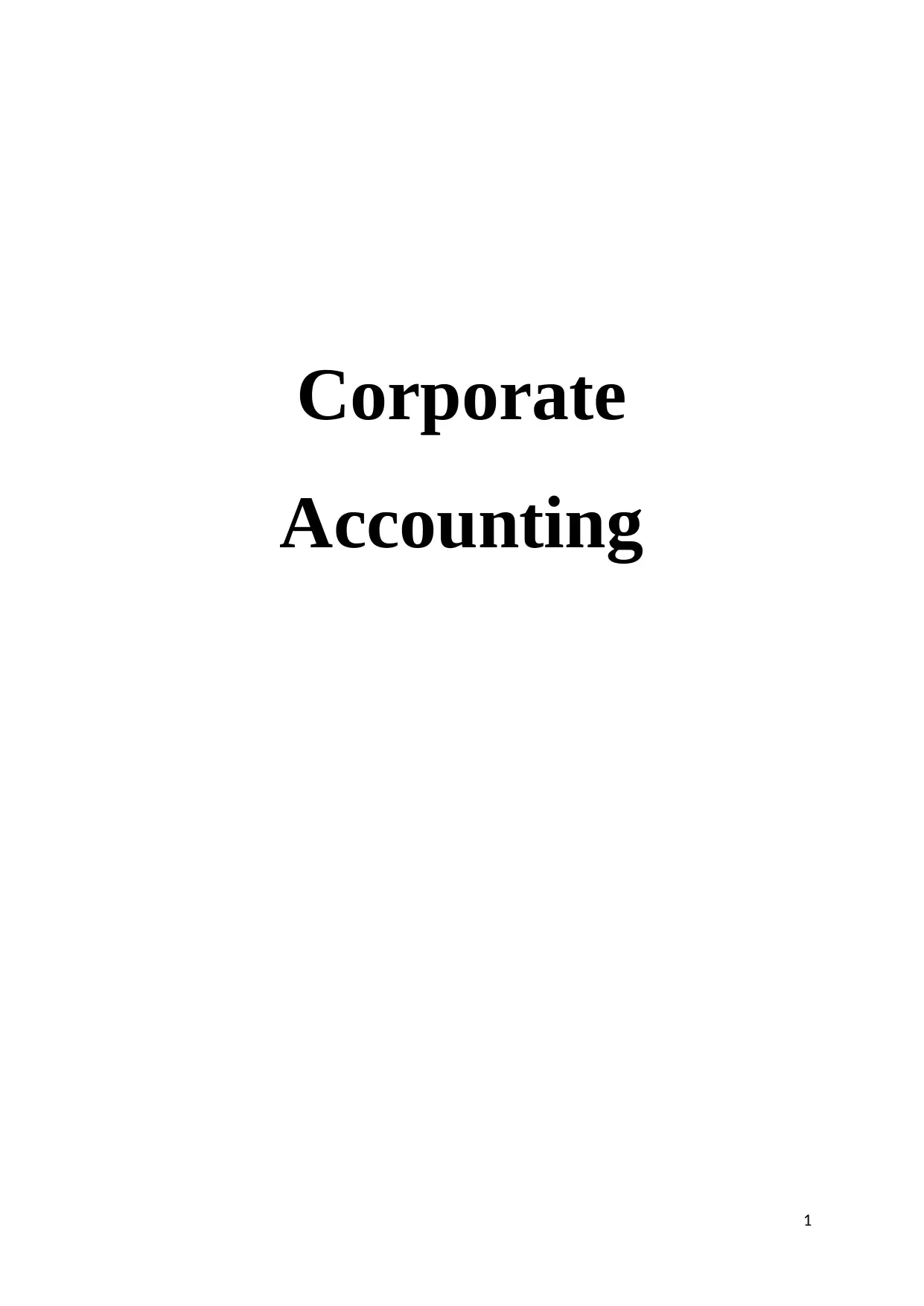
Corporate
Accounting
1
Accounting
1
Paraphrase This Document
Need a fresh take? Get an instant paraphrase of this document with our AI Paraphraser
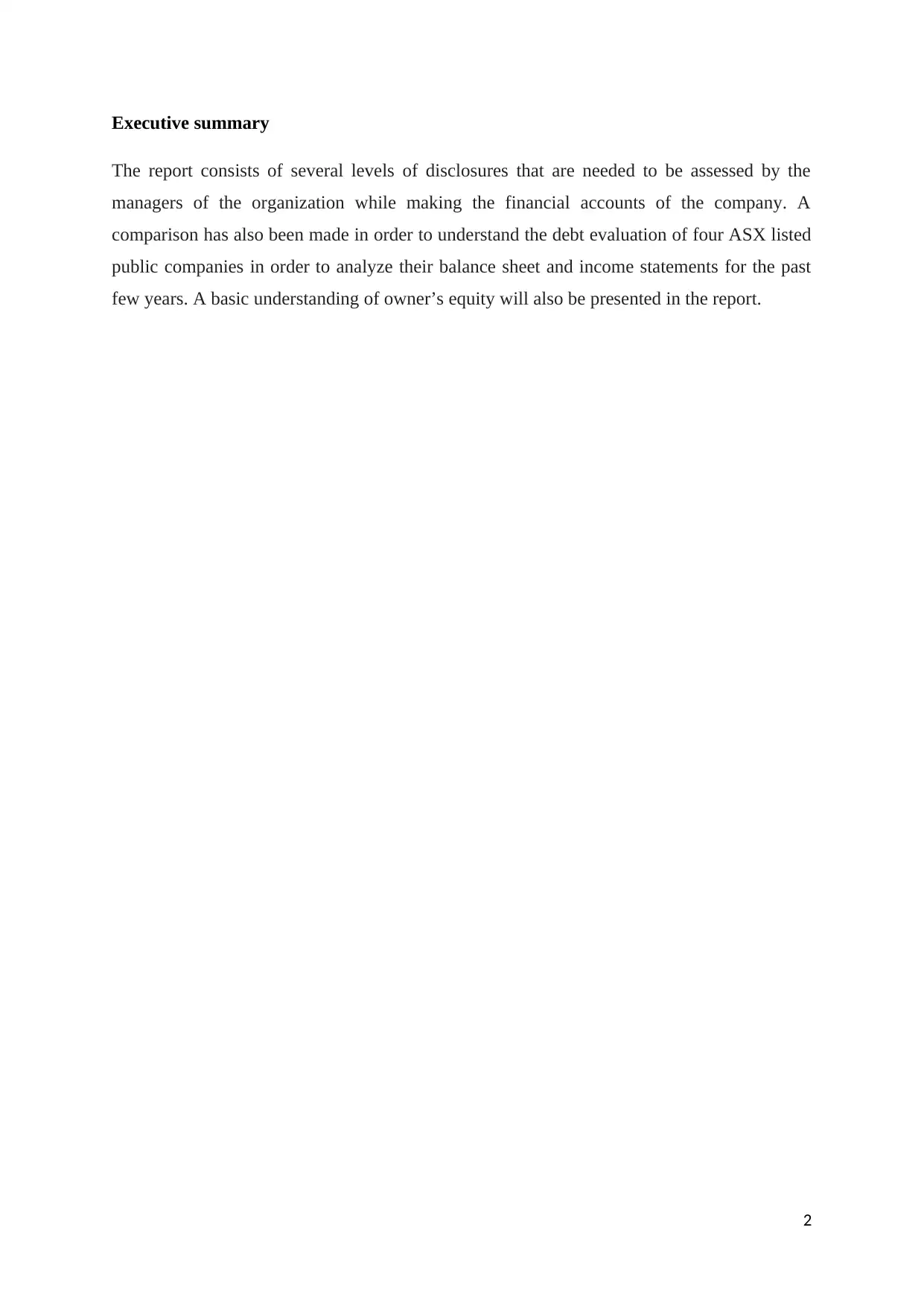
Executive summary
The report consists of several levels of disclosures that are needed to be assessed by the
managers of the organization while making the financial accounts of the company. A
comparison has also been made in order to understand the debt evaluation of four ASX listed
public companies in order to analyze their balance sheet and income statements for the past
few years. A basic understanding of owner’s equity will also be presented in the report.
2
The report consists of several levels of disclosures that are needed to be assessed by the
managers of the organization while making the financial accounts of the company. A
comparison has also been made in order to understand the debt evaluation of four ASX listed
public companies in order to analyze their balance sheet and income statements for the past
few years. A basic understanding of owner’s equity will also be presented in the report.
2
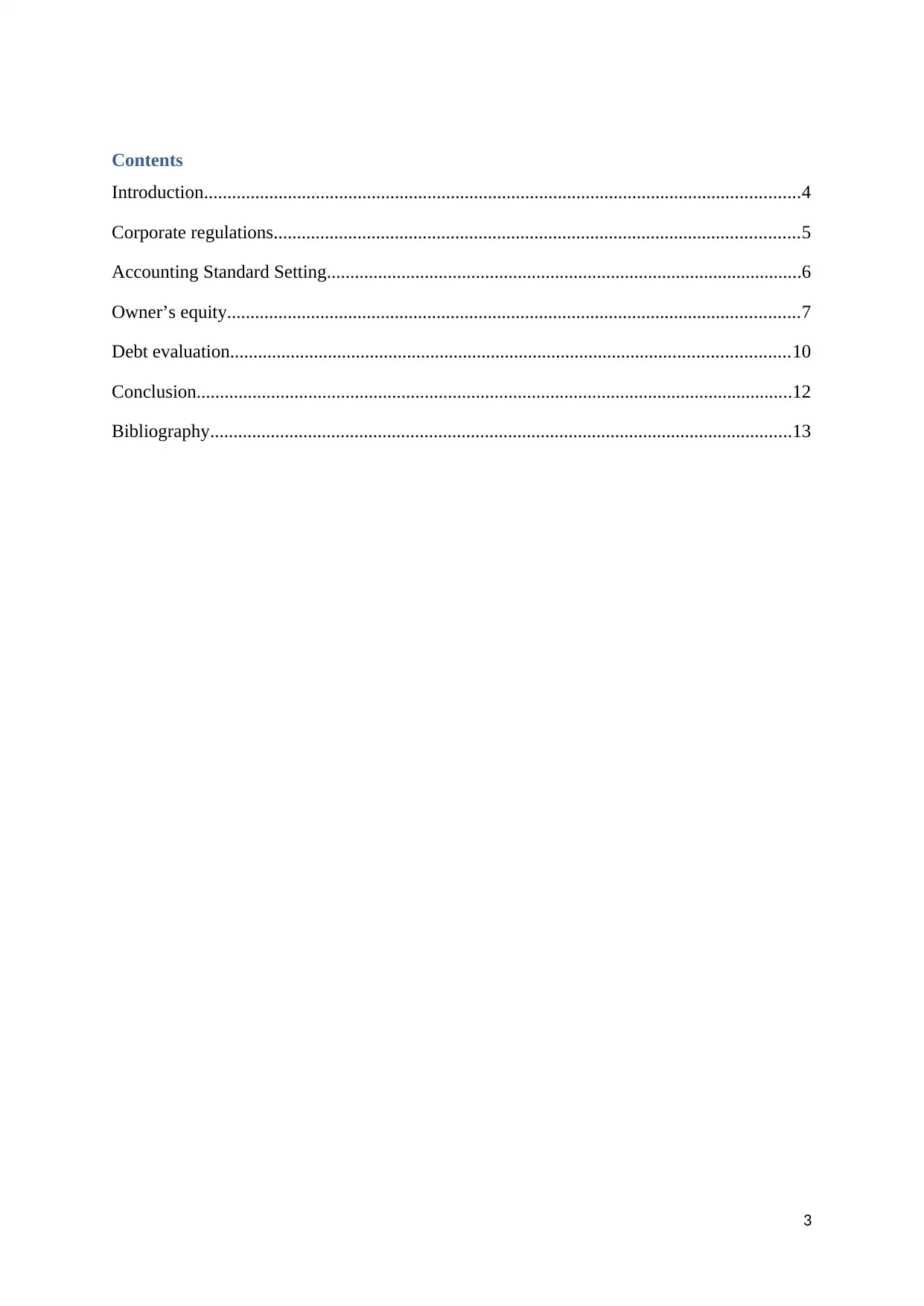
Contents
Introduction................................................................................................................................4
Corporate regulations.................................................................................................................5
Accounting Standard Setting......................................................................................................6
Owner’s equity...........................................................................................................................7
Debt evaluation........................................................................................................................10
Conclusion................................................................................................................................12
Bibliography.............................................................................................................................13
3
Introduction................................................................................................................................4
Corporate regulations.................................................................................................................5
Accounting Standard Setting......................................................................................................6
Owner’s equity...........................................................................................................................7
Debt evaluation........................................................................................................................10
Conclusion................................................................................................................................12
Bibliography.............................................................................................................................13
3
⊘ This is a preview!⊘
Do you want full access?
Subscribe today to unlock all pages.

Trusted by 1+ million students worldwide
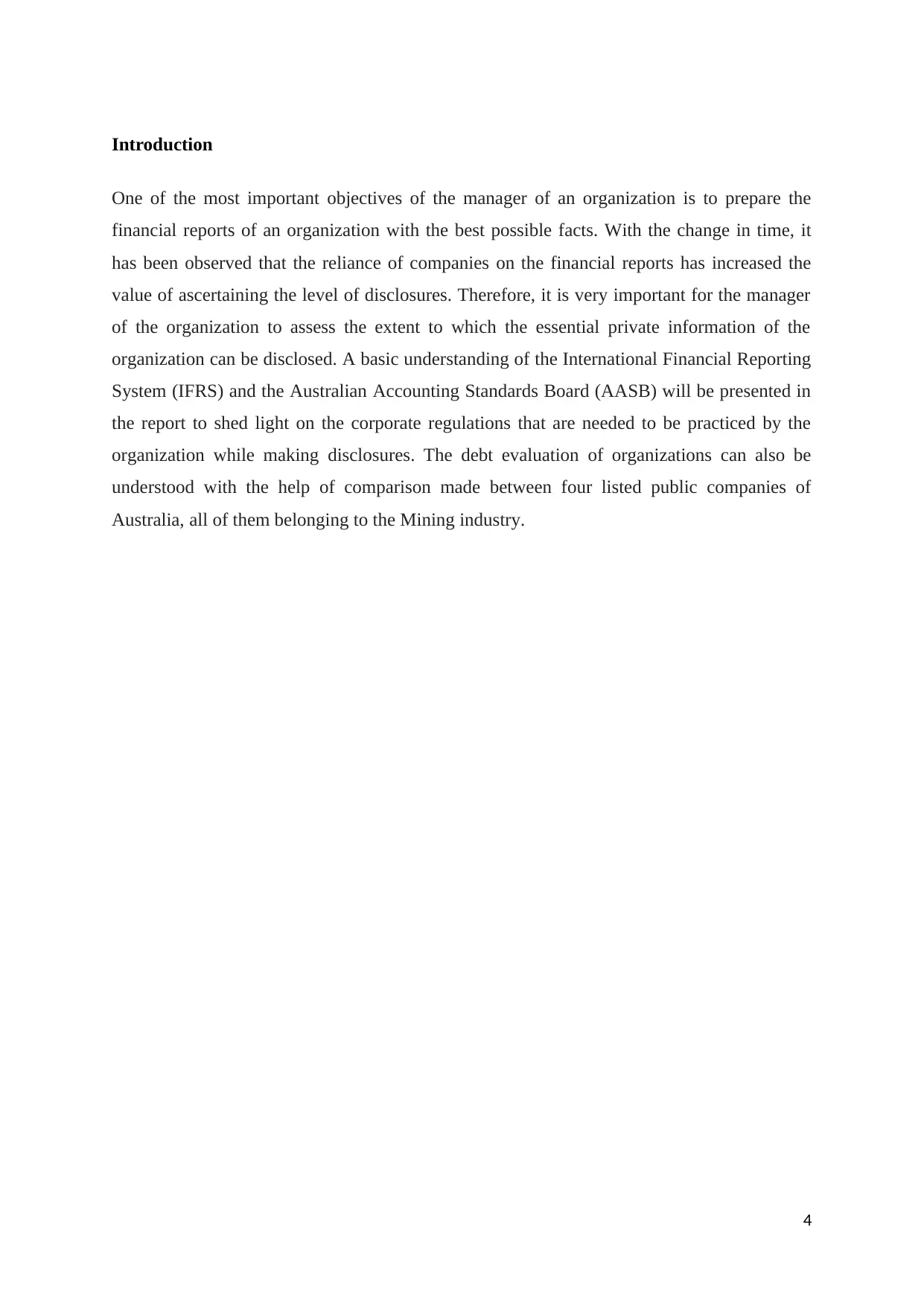
Introduction
One of the most important objectives of the manager of an organization is to prepare the
financial reports of an organization with the best possible facts. With the change in time, it
has been observed that the reliance of companies on the financial reports has increased the
value of ascertaining the level of disclosures. Therefore, it is very important for the manager
of the organization to assess the extent to which the essential private information of the
organization can be disclosed. A basic understanding of the International Financial Reporting
System (IFRS) and the Australian Accounting Standards Board (AASB) will be presented in
the report to shed light on the corporate regulations that are needed to be practiced by the
organization while making disclosures. The debt evaluation of organizations can also be
understood with the help of comparison made between four listed public companies of
Australia, all of them belonging to the Mining industry.
4
One of the most important objectives of the manager of an organization is to prepare the
financial reports of an organization with the best possible facts. With the change in time, it
has been observed that the reliance of companies on the financial reports has increased the
value of ascertaining the level of disclosures. Therefore, it is very important for the manager
of the organization to assess the extent to which the essential private information of the
organization can be disclosed. A basic understanding of the International Financial Reporting
System (IFRS) and the Australian Accounting Standards Board (AASB) will be presented in
the report to shed light on the corporate regulations that are needed to be practiced by the
organization while making disclosures. The debt evaluation of organizations can also be
understood with the help of comparison made between four listed public companies of
Australia, all of them belonging to the Mining industry.
4
Paraphrase This Document
Need a fresh take? Get an instant paraphrase of this document with our AI Paraphraser
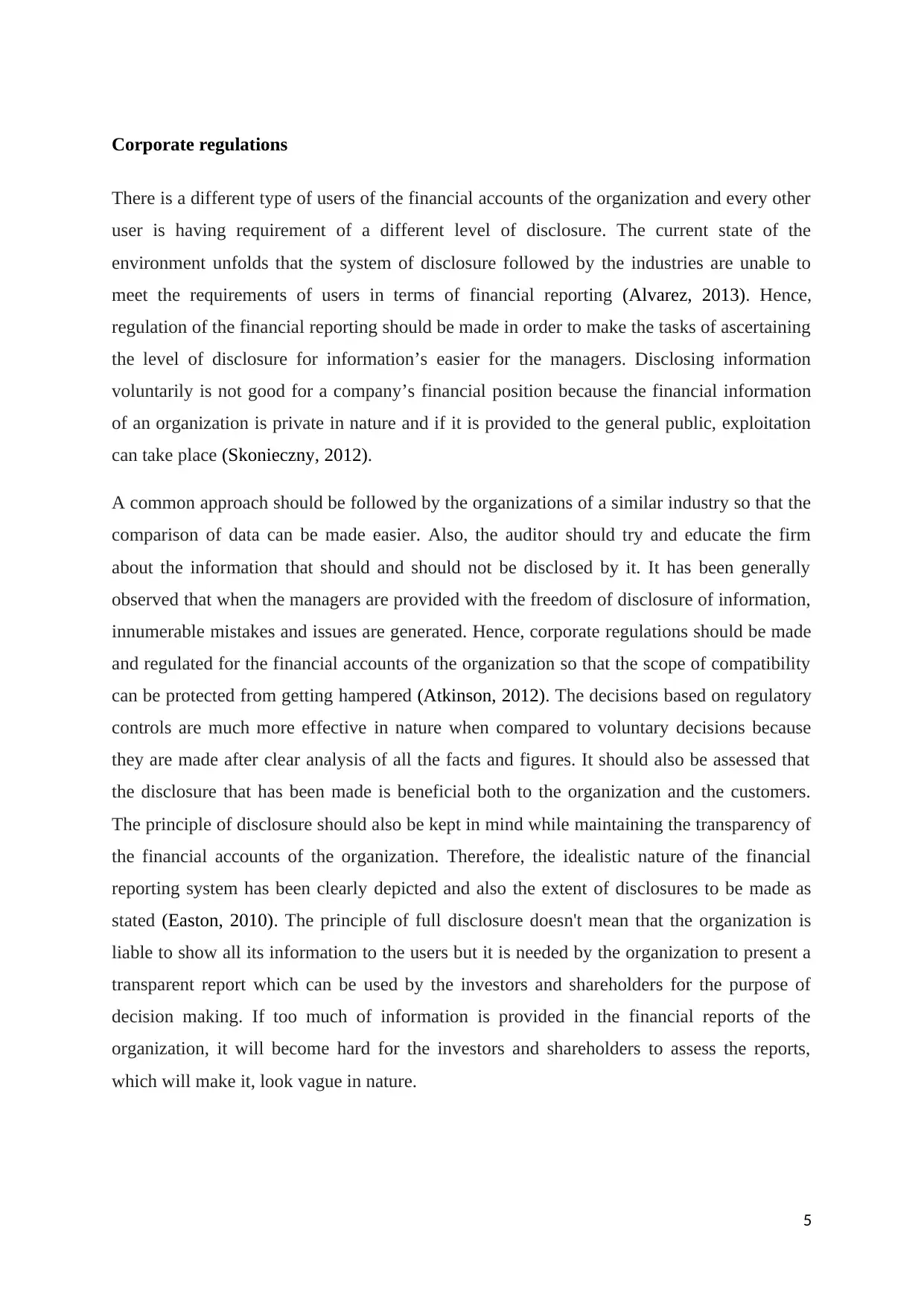
Corporate regulations
There is a different type of users of the financial accounts of the organization and every other
user is having requirement of a different level of disclosure. The current state of the
environment unfolds that the system of disclosure followed by the industries are unable to
meet the requirements of users in terms of financial reporting (Alvarez, 2013). Hence,
regulation of the financial reporting should be made in order to make the tasks of ascertaining
the level of disclosure for information’s easier for the managers. Disclosing information
voluntarily is not good for a company’s financial position because the financial information
of an organization is private in nature and if it is provided to the general public, exploitation
can take place (Skonieczny, 2012).
A common approach should be followed by the organizations of a similar industry so that the
comparison of data can be made easier. Also, the auditor should try and educate the firm
about the information that should and should not be disclosed by it. It has been generally
observed that when the managers are provided with the freedom of disclosure of information,
innumerable mistakes and issues are generated. Hence, corporate regulations should be made
and regulated for the financial accounts of the organization so that the scope of compatibility
can be protected from getting hampered (Atkinson, 2012). The decisions based on regulatory
controls are much more effective in nature when compared to voluntary decisions because
they are made after clear analysis of all the facts and figures. It should also be assessed that
the disclosure that has been made is beneficial both to the organization and the customers.
The principle of disclosure should also be kept in mind while maintaining the transparency of
the financial accounts of the organization. Therefore, the idealistic nature of the financial
reporting system has been clearly depicted and also the extent of disclosures to be made as
stated (Easton, 2010). The principle of full disclosure doesn't mean that the organization is
liable to show all its information to the users but it is needed by the organization to present a
transparent report which can be used by the investors and shareholders for the purpose of
decision making. If too much of information is provided in the financial reports of the
organization, it will become hard for the investors and shareholders to assess the reports,
which will make it, look vague in nature.
5
There is a different type of users of the financial accounts of the organization and every other
user is having requirement of a different level of disclosure. The current state of the
environment unfolds that the system of disclosure followed by the industries are unable to
meet the requirements of users in terms of financial reporting (Alvarez, 2013). Hence,
regulation of the financial reporting should be made in order to make the tasks of ascertaining
the level of disclosure for information’s easier for the managers. Disclosing information
voluntarily is not good for a company’s financial position because the financial information
of an organization is private in nature and if it is provided to the general public, exploitation
can take place (Skonieczny, 2012).
A common approach should be followed by the organizations of a similar industry so that the
comparison of data can be made easier. Also, the auditor should try and educate the firm
about the information that should and should not be disclosed by it. It has been generally
observed that when the managers are provided with the freedom of disclosure of information,
innumerable mistakes and issues are generated. Hence, corporate regulations should be made
and regulated for the financial accounts of the organization so that the scope of compatibility
can be protected from getting hampered (Atkinson, 2012). The decisions based on regulatory
controls are much more effective in nature when compared to voluntary decisions because
they are made after clear analysis of all the facts and figures. It should also be assessed that
the disclosure that has been made is beneficial both to the organization and the customers.
The principle of disclosure should also be kept in mind while maintaining the transparency of
the financial accounts of the organization. Therefore, the idealistic nature of the financial
reporting system has been clearly depicted and also the extent of disclosures to be made as
stated (Easton, 2010). The principle of full disclosure doesn't mean that the organization is
liable to show all its information to the users but it is needed by the organization to present a
transparent report which can be used by the investors and shareholders for the purpose of
decision making. If too much of information is provided in the financial reports of the
organization, it will become hard for the investors and shareholders to assess the reports,
which will make it, look vague in nature.
5
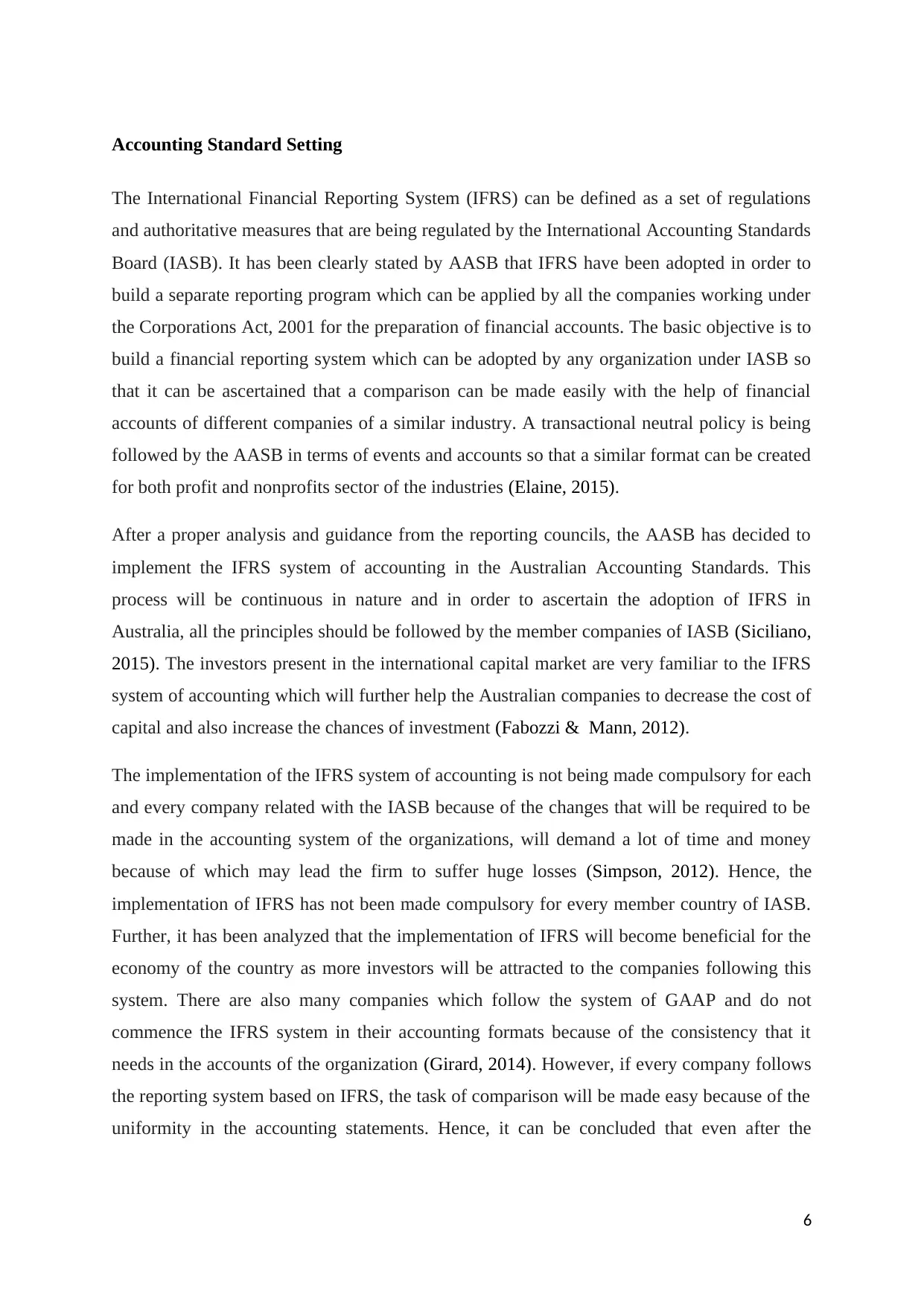
Accounting Standard Setting
The International Financial Reporting System (IFRS) can be defined as a set of regulations
and authoritative measures that are being regulated by the International Accounting Standards
Board (IASB). It has been clearly stated by AASB that IFRS have been adopted in order to
build a separate reporting program which can be applied by all the companies working under
the Corporations Act, 2001 for the preparation of financial accounts. The basic objective is to
build a financial reporting system which can be adopted by any organization under IASB so
that it can be ascertained that a comparison can be made easily with the help of financial
accounts of different companies of a similar industry. A transactional neutral policy is being
followed by the AASB in terms of events and accounts so that a similar format can be created
for both profit and nonprofits sector of the industries (Elaine, 2015).
After a proper analysis and guidance from the reporting councils, the AASB has decided to
implement the IFRS system of accounting in the Australian Accounting Standards. This
process will be continuous in nature and in order to ascertain the adoption of IFRS in
Australia, all the principles should be followed by the member companies of IASB (Siciliano,
2015). The investors present in the international capital market are very familiar to the IFRS
system of accounting which will further help the Australian companies to decrease the cost of
capital and also increase the chances of investment (Fabozzi & Mann, 2012).
The implementation of the IFRS system of accounting is not being made compulsory for each
and every company related with the IASB because of the changes that will be required to be
made in the accounting system of the organizations, will demand a lot of time and money
because of which may lead the firm to suffer huge losses (Simpson, 2012). Hence, the
implementation of IFRS has not been made compulsory for every member country of IASB.
Further, it has been analyzed that the implementation of IFRS will become beneficial for the
economy of the country as more investors will be attracted to the companies following this
system. There are also many companies which follow the system of GAAP and do not
commence the IFRS system in their accounting formats because of the consistency that it
needs in the accounts of the organization (Girard, 2014). However, if every company follows
the reporting system based on IFRS, the task of comparison will be made easy because of the
uniformity in the accounting statements. Hence, it can be concluded that even after the
6
The International Financial Reporting System (IFRS) can be defined as a set of regulations
and authoritative measures that are being regulated by the International Accounting Standards
Board (IASB). It has been clearly stated by AASB that IFRS have been adopted in order to
build a separate reporting program which can be applied by all the companies working under
the Corporations Act, 2001 for the preparation of financial accounts. The basic objective is to
build a financial reporting system which can be adopted by any organization under IASB so
that it can be ascertained that a comparison can be made easily with the help of financial
accounts of different companies of a similar industry. A transactional neutral policy is being
followed by the AASB in terms of events and accounts so that a similar format can be created
for both profit and nonprofits sector of the industries (Elaine, 2015).
After a proper analysis and guidance from the reporting councils, the AASB has decided to
implement the IFRS system of accounting in the Australian Accounting Standards. This
process will be continuous in nature and in order to ascertain the adoption of IFRS in
Australia, all the principles should be followed by the member companies of IASB (Siciliano,
2015). The investors present in the international capital market are very familiar to the IFRS
system of accounting which will further help the Australian companies to decrease the cost of
capital and also increase the chances of investment (Fabozzi & Mann, 2012).
The implementation of the IFRS system of accounting is not being made compulsory for each
and every company related with the IASB because of the changes that will be required to be
made in the accounting system of the organizations, will demand a lot of time and money
because of which may lead the firm to suffer huge losses (Simpson, 2012). Hence, the
implementation of IFRS has not been made compulsory for every member country of IASB.
Further, it has been analyzed that the implementation of IFRS will become beneficial for the
economy of the country as more investors will be attracted to the companies following this
system. There are also many companies which follow the system of GAAP and do not
commence the IFRS system in their accounting formats because of the consistency that it
needs in the accounts of the organization (Girard, 2014). However, if every company follows
the reporting system based on IFRS, the task of comparison will be made easy because of the
uniformity in the accounting statements. Hence, it can be concluded that even after the
6
⊘ This is a preview!⊘
Do you want full access?
Subscribe today to unlock all pages.

Trusted by 1+ million students worldwide
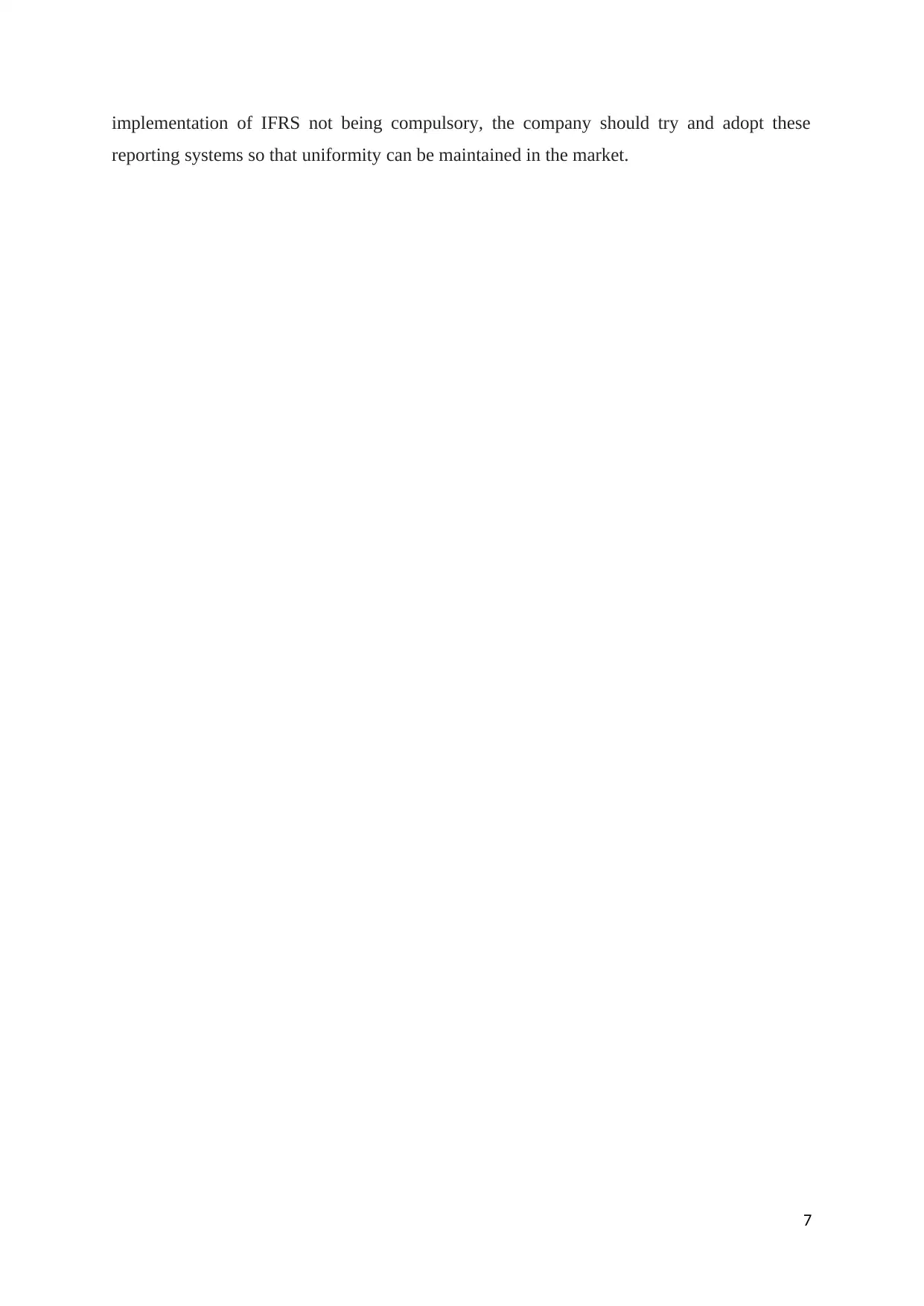
implementation of IFRS not being compulsory, the company should try and adopt these
reporting systems so that uniformity can be maintained in the market.
7
reporting systems so that uniformity can be maintained in the market.
7
Paraphrase This Document
Need a fresh take? Get an instant paraphrase of this document with our AI Paraphraser
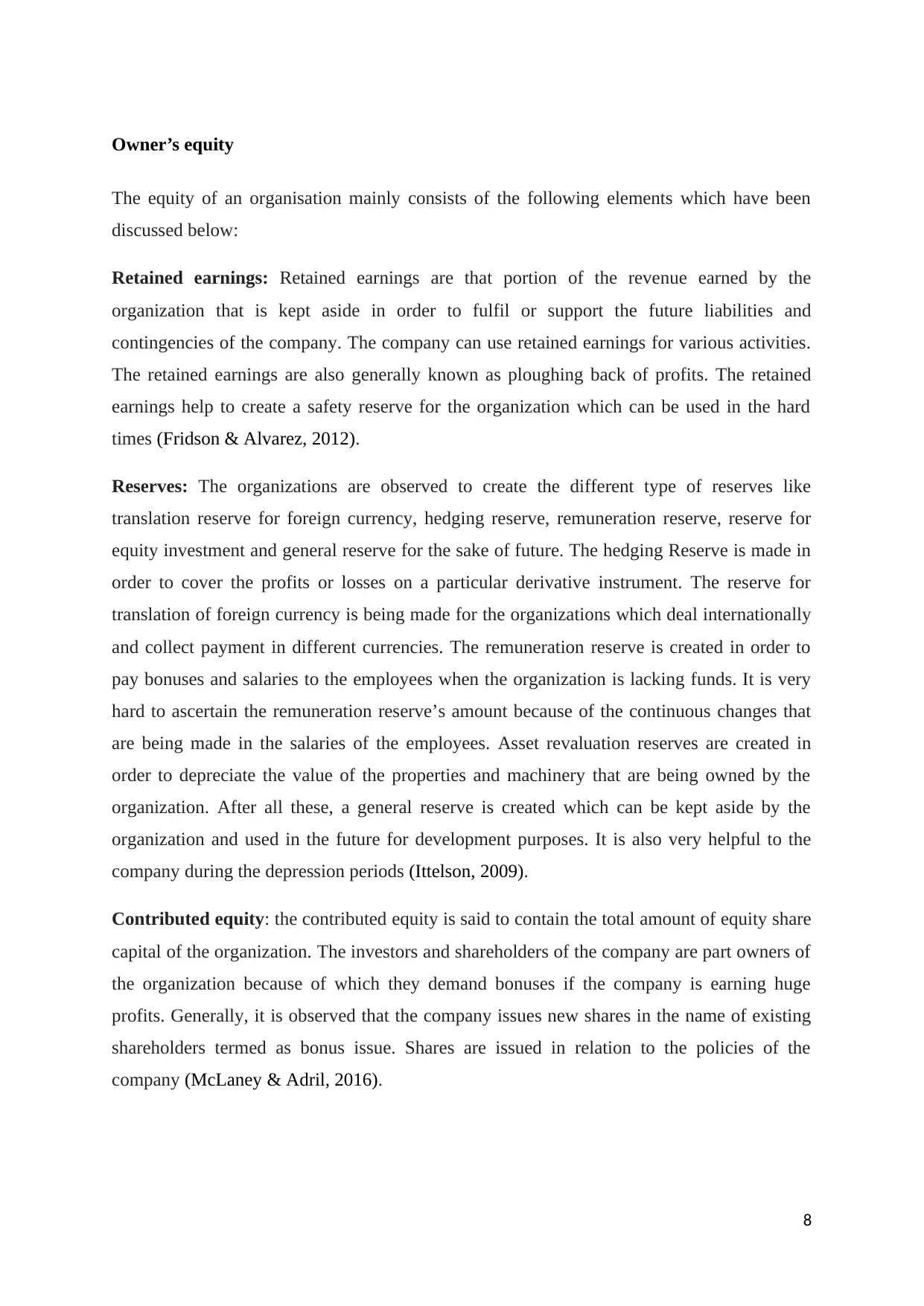
Owner’s equity
The equity of an organisation mainly consists of the following elements which have been
discussed below:
Retained earnings: Retained earnings are that portion of the revenue earned by the
organization that is kept aside in order to fulfil or support the future liabilities and
contingencies of the company. The company can use retained earnings for various activities.
The retained earnings are also generally known as ploughing back of profits. The retained
earnings help to create a safety reserve for the organization which can be used in the hard
times (Fridson & Alvarez, 2012).
Reserves: The organizations are observed to create the different type of reserves like
translation reserve for foreign currency, hedging reserve, remuneration reserve, reserve for
equity investment and general reserve for the sake of future. The hedging Reserve is made in
order to cover the profits or losses on a particular derivative instrument. The reserve for
translation of foreign currency is being made for the organizations which deal internationally
and collect payment in different currencies. The remuneration reserve is created in order to
pay bonuses and salaries to the employees when the organization is lacking funds. It is very
hard to ascertain the remuneration reserve’s amount because of the continuous changes that
are being made in the salaries of the employees. Asset revaluation reserves are created in
order to depreciate the value of the properties and machinery that are being owned by the
organization. After all these, a general reserve is created which can be kept aside by the
organization and used in the future for development purposes. It is also very helpful to the
company during the depression periods (Ittelson, 2009).
Contributed equity: the contributed equity is said to contain the total amount of equity share
capital of the organization. The investors and shareholders of the company are part owners of
the organization because of which they demand bonuses if the company is earning huge
profits. Generally, it is observed that the company issues new shares in the name of existing
shareholders termed as bonus issue. Shares are issued in relation to the policies of the
company (McLaney & Adril, 2016).
8
The equity of an organisation mainly consists of the following elements which have been
discussed below:
Retained earnings: Retained earnings are that portion of the revenue earned by the
organization that is kept aside in order to fulfil or support the future liabilities and
contingencies of the company. The company can use retained earnings for various activities.
The retained earnings are also generally known as ploughing back of profits. The retained
earnings help to create a safety reserve for the organization which can be used in the hard
times (Fridson & Alvarez, 2012).
Reserves: The organizations are observed to create the different type of reserves like
translation reserve for foreign currency, hedging reserve, remuneration reserve, reserve for
equity investment and general reserve for the sake of future. The hedging Reserve is made in
order to cover the profits or losses on a particular derivative instrument. The reserve for
translation of foreign currency is being made for the organizations which deal internationally
and collect payment in different currencies. The remuneration reserve is created in order to
pay bonuses and salaries to the employees when the organization is lacking funds. It is very
hard to ascertain the remuneration reserve’s amount because of the continuous changes that
are being made in the salaries of the employees. Asset revaluation reserves are created in
order to depreciate the value of the properties and machinery that are being owned by the
organization. After all these, a general reserve is created which can be kept aside by the
organization and used in the future for development purposes. It is also very helpful to the
company during the depression periods (Ittelson, 2009).
Contributed equity: the contributed equity is said to contain the total amount of equity share
capital of the organization. The investors and shareholders of the company are part owners of
the organization because of which they demand bonuses if the company is earning huge
profits. Generally, it is observed that the company issues new shares in the name of existing
shareholders termed as bonus issue. Shares are issued in relation to the policies of the
company (McLaney & Adril, 2016).
8
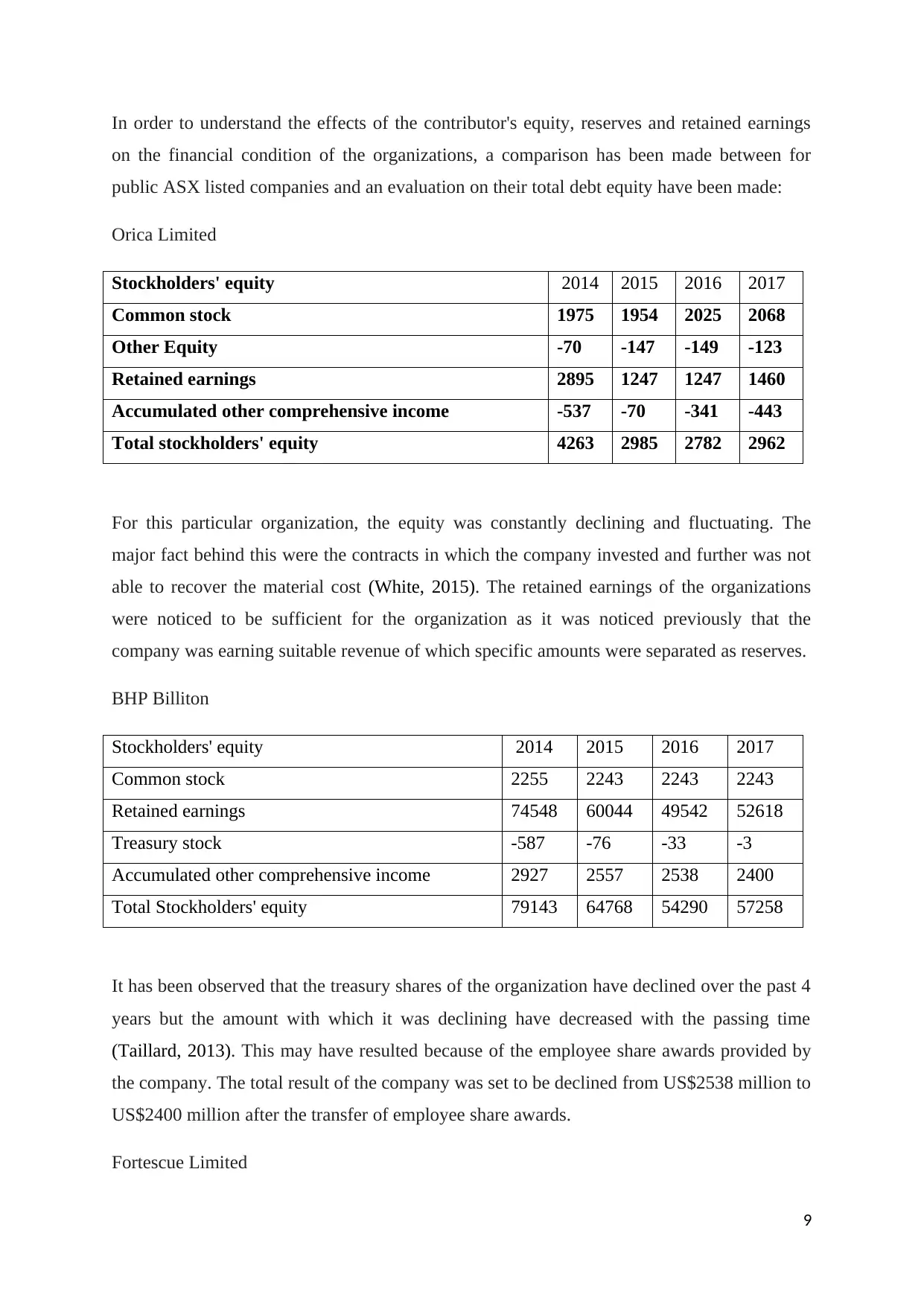
In order to understand the effects of the contributor's equity, reserves and retained earnings
on the financial condition of the organizations, a comparison has been made between for
public ASX listed companies and an evaluation on their total debt equity have been made:
Orica Limited
Stockholders' equity 2014 2015 2016 2017
Common stock 1975 1954 2025 2068
Other Equity -70 -147 -149 -123
Retained earnings 2895 1247 1247 1460
Accumulated other comprehensive income -537 -70 -341 -443
Total stockholders' equity 4263 2985 2782 2962
For this particular organization, the equity was constantly declining and fluctuating. The
major fact behind this were the contracts in which the company invested and further was not
able to recover the material cost (White, 2015). The retained earnings of the organizations
were noticed to be sufficient for the organization as it was noticed previously that the
company was earning suitable revenue of which specific amounts were separated as reserves.
BHP Billiton
Stockholders' equity 2014 2015 2016 2017
Common stock 2255 2243 2243 2243
Retained earnings 74548 60044 49542 52618
Treasury stock -587 -76 -33 -3
Accumulated other comprehensive income 2927 2557 2538 2400
Total Stockholders' equity 79143 64768 54290 57258
It has been observed that the treasury shares of the organization have declined over the past 4
years but the amount with which it was declining have decreased with the passing time
(Taillard, 2013). This may have resulted because of the employee share awards provided by
the company. The total result of the company was set to be declined from US$2538 million to
US$2400 million after the transfer of employee share awards.
Fortescue Limited
9
on the financial condition of the organizations, a comparison has been made between for
public ASX listed companies and an evaluation on their total debt equity have been made:
Orica Limited
Stockholders' equity 2014 2015 2016 2017
Common stock 1975 1954 2025 2068
Other Equity -70 -147 -149 -123
Retained earnings 2895 1247 1247 1460
Accumulated other comprehensive income -537 -70 -341 -443
Total stockholders' equity 4263 2985 2782 2962
For this particular organization, the equity was constantly declining and fluctuating. The
major fact behind this were the contracts in which the company invested and further was not
able to recover the material cost (White, 2015). The retained earnings of the organizations
were noticed to be sufficient for the organization as it was noticed previously that the
company was earning suitable revenue of which specific amounts were separated as reserves.
BHP Billiton
Stockholders' equity 2014 2015 2016 2017
Common stock 2255 2243 2243 2243
Retained earnings 74548 60044 49542 52618
Treasury stock -587 -76 -33 -3
Accumulated other comprehensive income 2927 2557 2538 2400
Total Stockholders' equity 79143 64768 54290 57258
It has been observed that the treasury shares of the organization have declined over the past 4
years but the amount with which it was declining have decreased with the passing time
(Taillard, 2013). This may have resulted because of the employee share awards provided by
the company. The total result of the company was set to be declined from US$2538 million to
US$2400 million after the transfer of employee share awards.
Fortescue Limited
9
⊘ This is a preview!⊘
Do you want full access?
Subscribe today to unlock all pages.

Trusted by 1+ million students worldwide
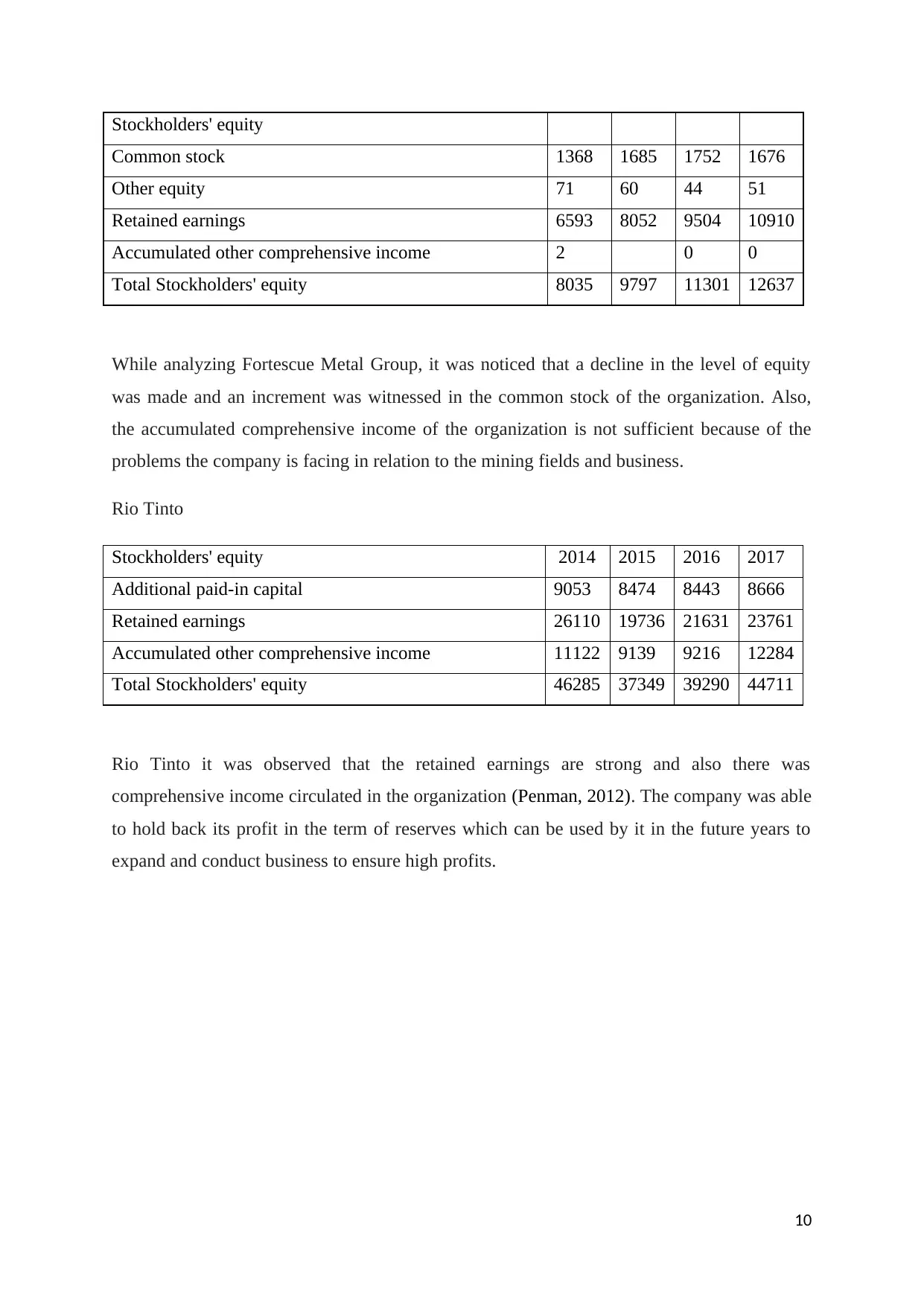
Stockholders' equity
Common stock 1368 1685 1752 1676
Other equity 71 60 44 51
Retained earnings 6593 8052 9504 10910
Accumulated other comprehensive income 2 0 0
Total Stockholders' equity 8035 9797 11301 12637
While analyzing Fortescue Metal Group, it was noticed that a decline in the level of equity
was made and an increment was witnessed in the common stock of the organization. Also,
the accumulated comprehensive income of the organization is not sufficient because of the
problems the company is facing in relation to the mining fields and business.
Rio Tinto
Stockholders' equity 2014 2015 2016 2017
Additional paid-in capital 9053 8474 8443 8666
Retained earnings 26110 19736 21631 23761
Accumulated other comprehensive income 11122 9139 9216 12284
Total Stockholders' equity 46285 37349 39290 44711
Rio Tinto it was observed that the retained earnings are strong and also there was
comprehensive income circulated in the organization (Penman, 2012). The company was able
to hold back its profit in the term of reserves which can be used by it in the future years to
expand and conduct business to ensure high profits.
10
Common stock 1368 1685 1752 1676
Other equity 71 60 44 51
Retained earnings 6593 8052 9504 10910
Accumulated other comprehensive income 2 0 0
Total Stockholders' equity 8035 9797 11301 12637
While analyzing Fortescue Metal Group, it was noticed that a decline in the level of equity
was made and an increment was witnessed in the common stock of the organization. Also,
the accumulated comprehensive income of the organization is not sufficient because of the
problems the company is facing in relation to the mining fields and business.
Rio Tinto
Stockholders' equity 2014 2015 2016 2017
Additional paid-in capital 9053 8474 8443 8666
Retained earnings 26110 19736 21631 23761
Accumulated other comprehensive income 11122 9139 9216 12284
Total Stockholders' equity 46285 37349 39290 44711
Rio Tinto it was observed that the retained earnings are strong and also there was
comprehensive income circulated in the organization (Penman, 2012). The company was able
to hold back its profit in the term of reserves which can be used by it in the future years to
expand and conduct business to ensure high profits.
10
Paraphrase This Document
Need a fresh take? Get an instant paraphrase of this document with our AI Paraphraser
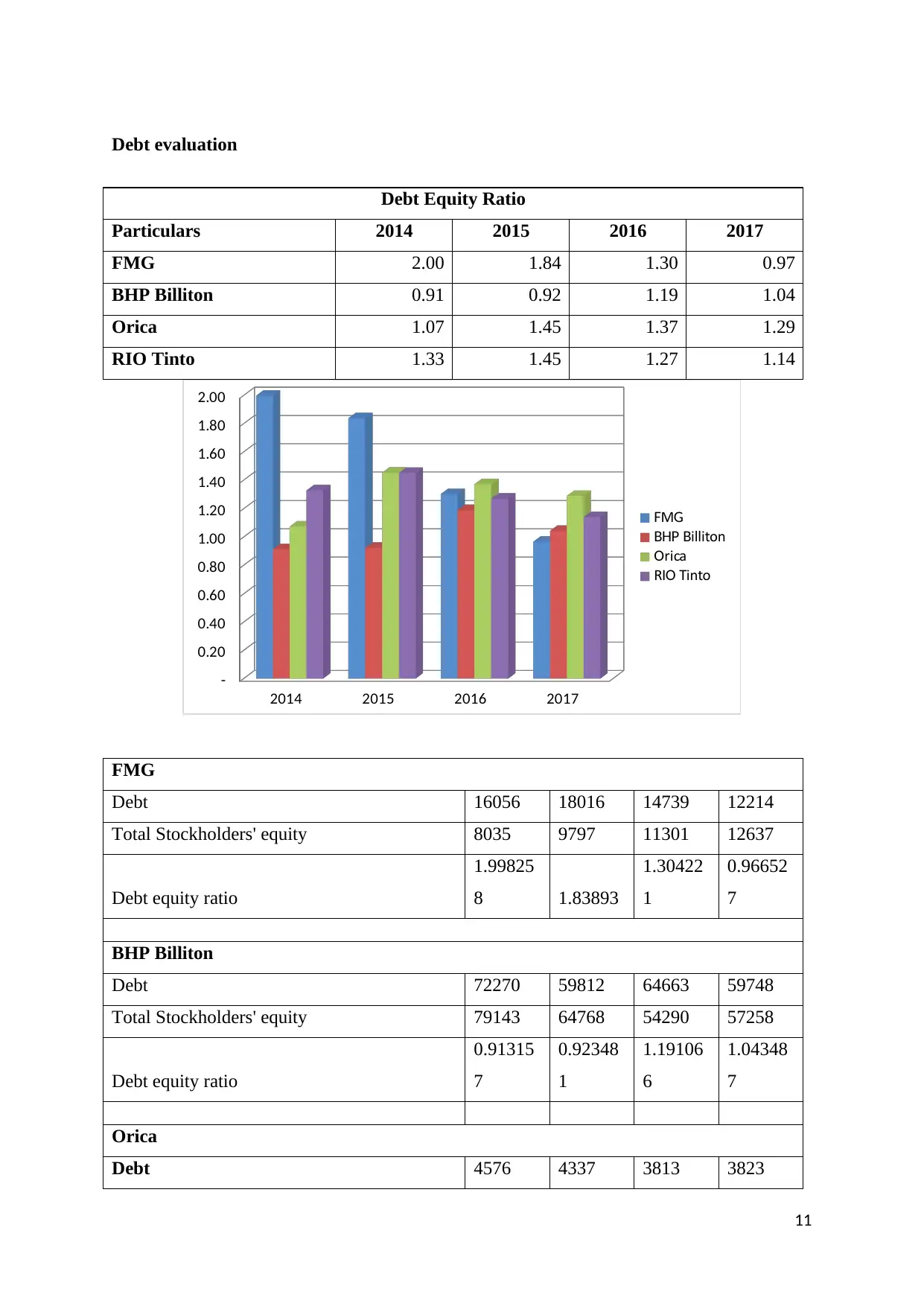
Debt evaluation
Debt Equity Ratio
Particulars 2014 2015 2016 2017
FMG 2.00 1.84 1.30 0.97
BHP Billiton 0.91 0.92 1.19 1.04
Orica 1.07 1.45 1.37 1.29
RIO Tinto 1.33 1.45 1.27 1.14
2014 2015 2016 2017
-
0.20
0.40
0.60
0.80
1.00
1.20
1.40
1.60
1.80
2.00
MF G
illitonBHP B
ricaO
R intoIO T
FMG
Debt 16056 18016 14739 12214
Total Stockholders' equity 8035 9797 11301 12637
Debt equity ratio
1.99825
8 1.83893
1.30422
1
0.96652
7
BHP Billiton
Debt 72270 59812 64663 59748
Total Stockholders' equity 79143 64768 54290 57258
Debt equity ratio
0.91315
7
0.92348
1
1.19106
6
1.04348
7
Orica
Debt 4576 4337 3813 3823
11
Debt Equity Ratio
Particulars 2014 2015 2016 2017
FMG 2.00 1.84 1.30 0.97
BHP Billiton 0.91 0.92 1.19 1.04
Orica 1.07 1.45 1.37 1.29
RIO Tinto 1.33 1.45 1.27 1.14
2014 2015 2016 2017
-
0.20
0.40
0.60
0.80
1.00
1.20
1.40
1.60
1.80
2.00
MF G
illitonBHP B
ricaO
R intoIO T
FMG
Debt 16056 18016 14739 12214
Total Stockholders' equity 8035 9797 11301 12637
Debt equity ratio
1.99825
8 1.83893
1.30422
1
0.96652
7
BHP Billiton
Debt 72270 59812 64663 59748
Total Stockholders' equity 79143 64768 54290 57258
Debt equity ratio
0.91315
7
0.92348
1
1.19106
6
1.04348
7
Orica
Debt 4576 4337 3813 3823
11
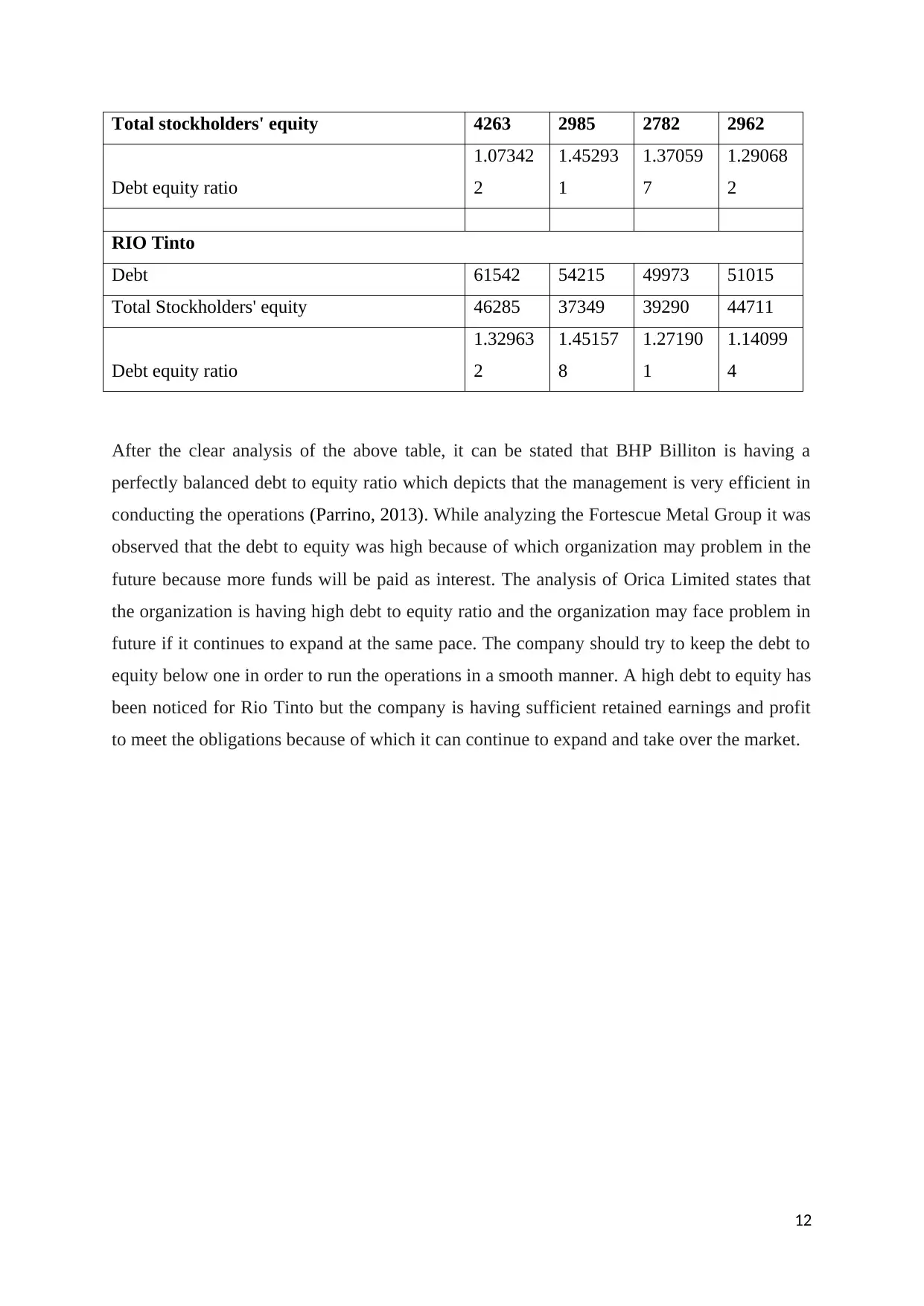
Total stockholders' equity 4263 2985 2782 2962
Debt equity ratio
1.07342
2
1.45293
1
1.37059
7
1.29068
2
RIO Tinto
Debt 61542 54215 49973 51015
Total Stockholders' equity 46285 37349 39290 44711
Debt equity ratio
1.32963
2
1.45157
8
1.27190
1
1.14099
4
After the clear analysis of the above table, it can be stated that BHP Billiton is having a
perfectly balanced debt to equity ratio which depicts that the management is very efficient in
conducting the operations (Parrino, 2013). While analyzing the Fortescue Metal Group it was
observed that the debt to equity was high because of which organization may problem in the
future because more funds will be paid as interest. The analysis of Orica Limited states that
the organization is having high debt to equity ratio and the organization may face problem in
future if it continues to expand at the same pace. The company should try to keep the debt to
equity below one in order to run the operations in a smooth manner. A high debt to equity has
been noticed for Rio Tinto but the company is having sufficient retained earnings and profit
to meet the obligations because of which it can continue to expand and take over the market.
12
Debt equity ratio
1.07342
2
1.45293
1
1.37059
7
1.29068
2
RIO Tinto
Debt 61542 54215 49973 51015
Total Stockholders' equity 46285 37349 39290 44711
Debt equity ratio
1.32963
2
1.45157
8
1.27190
1
1.14099
4
After the clear analysis of the above table, it can be stated that BHP Billiton is having a
perfectly balanced debt to equity ratio which depicts that the management is very efficient in
conducting the operations (Parrino, 2013). While analyzing the Fortescue Metal Group it was
observed that the debt to equity was high because of which organization may problem in the
future because more funds will be paid as interest. The analysis of Orica Limited states that
the organization is having high debt to equity ratio and the organization may face problem in
future if it continues to expand at the same pace. The company should try to keep the debt to
equity below one in order to run the operations in a smooth manner. A high debt to equity has
been noticed for Rio Tinto but the company is having sufficient retained earnings and profit
to meet the obligations because of which it can continue to expand and take over the market.
12
⊘ This is a preview!⊘
Do you want full access?
Subscribe today to unlock all pages.

Trusted by 1+ million students worldwide
1 out of 15
Related Documents
Your All-in-One AI-Powered Toolkit for Academic Success.
+13062052269
info@desklib.com
Available 24*7 on WhatsApp / Email
![[object Object]](/_next/static/media/star-bottom.7253800d.svg)
Unlock your academic potential
Copyright © 2020–2025 A2Z Services. All Rights Reserved. Developed and managed by ZUCOL.



